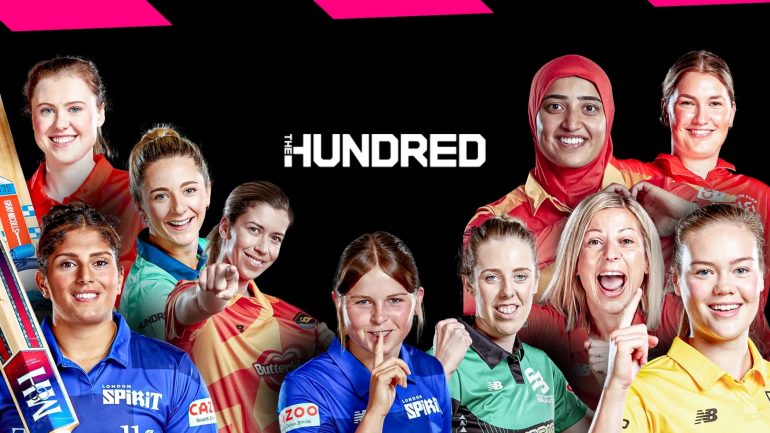Two matches started the 2024 version of The Hundred, between the Oval Invincibles and Birmingham Phoenix.
Results:
Women: OI 150-5; BP 105
Men: BP 89; OI 93-2
Here are a few disordered thoughts, centred on the women’s match.
The Shape of the Game
Did the crowd feel it got its money’s worth? Neither game had a tight finish.
Very similar to a T20. Team A score the big runs; Team B under pressure from the start, unable to raise a flicker of resistance.
The crowd realised the situation early on. When Charis Pavely hit a late four, there was barely a ripple of applause. Even the shortest game can rapidly become one-sided. If the home side holds the whip-hand, the crowd relaxes contentedly.
But the Phoenix were all too used to losing. The men’s game was even more one-sided. How far can/do the authorities go to ensure balanced sides competing?
Teams
The dreaded word ‘franchises’; players bought in from anywhere. ‘You’re worth ten quid, but she’s worth thirty. As for that other one, she’s not worth anything.’’
Players change franchises. Who’s playing for whom this year? Hence a constant rebuilding of team-spirit. The franchise that keeps hold of most of its players must hold an advantage.
Players may be available for only part of the tournament because of other commitments abroad. Who makes way? The big overseas star, or the promising English youngster who’s already proved her worth? I won’t stay for an answer. Nor will the promising English youngster.
Amanda-Jade Wellington bowled supremely well, but she’s not good enough (at present) to get into Australia’s side. So she comes to England and prevents an English player from appearing. The crowd is delighted. Are the England selectors?
Here are the two teams:
Oval Invincibles
Lauren Winfield-Hill (captain, w-k), Paige Scholfield, Alice Capsey, Marizanne Kapp, Mady Villiers, Laura Harris, Amanda-Jade Wellington, Jo Gardner, Ryana MacDonald-Gay, Sophia Smale, Rachel Slater
Birmingham Phoenix
Suzie Bates, Sterre Kalis, Ellyse Perry (captain), Sophie Devine, Amy Jones (w-k), Seren Smale, Emily Arlott, Issy Wong, Charis Pavely, Hannah Baker, Katie Levick
Phoenix placed four overseas players in the top four, three of whom could have been captain. The top scorer was Sterre Kalis of the Netherlands; the three star signings, Bates, Perry and Devine made 19 runs between them. Perry, widely considered the greatest female player now operating, ran herself out on what she hoped was a misfield. It wasn’t. Capsey struck. Perry made 0. Less than half the team have local roots.
Like Phoenix (Levick), Invincibles had a Yorkshirewoman in their midst, LWH. Neither is playing for Northern Superchargers, because that isn’t how franchise cricket works. Instead NS have Kate Cross (Lancashire through and through), and fourteen other players. The publicists were unable to procure headshots of five of them.
On the plus side, it was heartening to find three Celtic players across the two teams: the two Smales (Wales) and Rachel Slater (Scotland). But most of the successful SE Stars, also based at the Oval, were missing. Only three made the cut. Instead, OIs bought in the 33-year-old Laura Harris from Queensland. It’s hard to see why. She lasted one ball and wasn’t asked to bowl. Another English player denied the chance of taking the big stage.
Commentary
Is it the task of the (male) commentators to recognise every player and offer background details about her, or merely to parrot well known facts about the stars? As Rachel Slater came on, Morgan talked about Wellington at length, and why she might not be bowling.
His idea of commentary is to issue volleys of orders to the bowler (‘bowl wicket to wicket!’, ‘don’t drop it short!’). and ‘’why don’t they listen to what you say, Stuart (Broad)?’ — Why should they? How often did Stuart captain a team?
Viewers had a right to learn something about the young Scot.
Listen out for close analysis of the bowling. All the focus is on the batting, which is a major gripe I have about this shortest form of the game. The scorecard reflects this: we are shown dot balls; maiden overs (cough, splutter, ‘maiden-sets’) are an extinct species, their skeletons on show in the Science Museum.
The bowling needs far more focus.
Morgan talks from the back of his throat, which leaves the great commentators unworried by the competition.
The male commentators discuss their apparel, rather than the ball in play (who’s the fielder? – sorry, I was looking at his flares.’)
Instead of Sophia ‘Smale’, we had ‘Shmale’. Then Seren Smale became ‘Smarley’. Nothing like being on top of your job.
The moment Lydia Greenway took the mike, we received the info we should have had earlier.
Rules
We all know. The over is not an over; it’s replaced by ‘set’, which happens to be the English word with the most meanings of all, or by ‘five’. All those in favour of the metric system, shout ‘yippee!’ And the spectators are supposed to be so unfamiliar with the game that the umpires still need to wave a card in the air to indicate a change of ends.
Why was the word ‘over’ the only familiar term to be banned from the cricketing lexicon? ‘Five’ used to be one of the lovely rarities of the game. Nowadays it tends to come from a single and four overthrows. In the days when the distance from pitch to boundary wasn’t tightly regimented, the all-run five was not an endangered species. The Oval was large enough to offer many examples.
Coverage
Screen-score presentation – still very confusing, details on opposite sides and down below.
The triple-split screen for run-outs and stumpings is excellent, and saves time. One example came so fast that the TV umpire made his decision almost before the right camera was selected.
We are still subjected to the keeper’s cam, which is a most questionable offering. Nausea.
An Incident
5 penalty runs were awarded against Kapp for throwing the ball directly at Bates. Commentators excused her; umpires didn’t.









